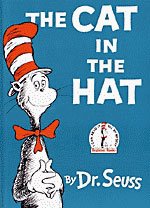Podcast 2 "Who" and "Whom"
Welcome back to English with the Techtutor. My name is Richard Blum.

Today we are going to do some pronunciation practice in a segment called English with an American accent.
Prepare to open your mouth wide and make “aah” sound. My friends Jean and Parks will lend their voices and recite a little poem in that part of our show.
We’ll also review a point of grammar. Today’s topic is When to use “who” and “whom”.
Finally, we will talk about an American writer of children’s books, Dr. Seuss.
As always, go to our website for the script of today’s program. You will also find definitions of some of the words and idioms you hear will hear in the next few minutes.
Let’s begin with some pronunciation practice. Try to exactly copy my accent.
Remember, To make the “aaah” sound you must open your mouth as wide as possible. Drop your chin and stretch the corners of your mouth until they hurt.
American’s may open their mouths wider than most. “Aaah” is one of the distinguishing sounds of American English.
Repeat these words after me.
Hat
Cat
Mat
Rat
Fat
If you have a microphone, record yourself. Compare your pronunciation to mine. To make the “aaah” sound, stretch your mouth as wide open as possible, lean your head slightly backwards and open your throat completely. Let the sound, it is a little high pitched, rise up from your stomach.
Repeat after me:
That
Ran
Apple
Back
Black
Pack
Sat
After
Nap
Cap
Now my friend Jean will recite a short ditty for you. A ditty is a short and silly poem.
She will pause after each line. Fill in the pauses with your voice.
Matt was a cat.
Pat was a rat.
The cat was fat.
The rat was black.
Pat ran after Matt.
The fat cat married the black rat.
What do you think about that?
Did you do it? Fantastic!
Try it again. This time Parks will lead you. Try to copy his pronunciation and rhythm.
Matt was a cat.
Pat was a rat.
The cat was fat.
The rat was black.
Pat ran after Matt.
The fat cat married the black rat.
What do you think about that?
Think about our story. I hope you remember the words. Let me recite them for you once more, and then , go ahead, and repeat the poem yourself.
Matt was a cat.
Pat was a rat.
The cat was fat.
The rat was black.
Pat ran after Matt.
The fat cat married the black rat.
What do you think about that?
It’s your turn now.
Now that we have done our exercises and are warmed up, let’s move on to examine a point of grammar.
Most Americans favor informality. Unlike the mad dog British upper class ,who pride themselves on maintaining a stiff upper lip and an unbending attitude in the face of adversity, few Americans would choose to wear a starched shirt, tie and formal jacket in the tropical noonday sun. Not many Americans want to be known as a “stuffed shirt” or a “pompous prig.”
It is no accident that one of the most loved of American authors, Mark Twain, found wisdom in the plain words and idioms of common people. He poked fun at the pretentious words and manners of those who thought themselves “a cut above” the rest.
Enter “who” and “whom”.
Who is a plain fellow and hard worker. Whom is slightly suspect. Some think “whom” is “putting on airs” and is a bit of a snob.
The rules for applying “who” and “whom” are simple.
In the subject of the sentence, use “who”.
In the object of the sentence or the object of a preposition, use “whom.”
Consider this: John kissed Mary on the cheek.
Who did what to whom.
John, the actor, kissed Mary, the object of his affection.
In question form this becomes, ”Who kissed whom where?”
Life, however, has a way of complicating simple decisions and convoluted sentences can leave us scratching our heads and wondering whether “who” or “whom” is the appropriate choice.
In our example of John and Mary, let’s imagine that the kiss was not on the cheek. Their mouths met in a lip lock. We now can ask, “Who kissed who? Or even, “Who put what where?”
Noah Webster, creator of the first American dictionary, foresaw these complications and considered banishing “whom” from American mouths.
H. L. Menken, a journalist and author of The American Language, a revered book on usage and grammar, wrote, “Now and then there arises a sort of panicky feeling that whom is being neglected, and so it is trotted out, but in the main the American language tends to dispense with it, at least in its less graceful situations. Noah Webster, always the pragmatic reformer, denounced it as long ago as 1783. Common sense, he argued, was on the side of “who did he marry?” Today such a form as “whom are you talking to?” would seem somewhat affected in ordinary discourse in America; “who are you talking to?” is heard a thousand times oftener, and is doubly American, for it substitutes who for whom and puts a preposition at the end of a sentence: two crimes that most English purists would seek to avoid.”
The Techtutor’s advice:
Err on the side of informality. When in doubt. Who is on first.
In this last segment of our show, I would like to introduce you to a very popular author of children’s books. His real name is Theodore Geisel, but he is better known by his pen name, Dr. Seuss. Dr. Seuss wrote many children’s books. The Cat in the Hat is one the most famous.
I read it to out loud to all four of my children when they were three or four years old.
I advise you to find a copy and read it out loud. Reading children’s books out loud is an excellent way to practice pronunciation. If you can find a young person to listen while you read, so much the better.
Dr. Seuss’ books are especially useful for pronunciation practice because he uses simple repeating patterns and rhythms.
Remember to drop your chin, lean your head slightly back and stretch the corners of your mouth when you read the “aaah” sounds in Cat in the Hat.
Visit our website, Techtutor.blogspot.com. for a complete script of today’s show. Toward the bottom of the script, you will find these first lines from the Cat in the Hat.
Of course, you can pause now to find the website.
Please join my fourteen year old daughter, Sophia, as she reads the first lines of Cat in the Hat.
Here she goes:
The sun did not shine.
It was too wet to play.
So we sat in the house.
All that cold, cold, wet day.
I sat there with Sally.
We sat there, we two.
And I said, “How I wish
We had something to do!”
Too wet to go out
And too cold to play ball.
So we sat in the house.
We did nothing at all.
So all we could do was to
Sit!
Sit!
Sit!
Sit!
And we did not like it,
Not one little bit.
And then,
Something went bump
And the bump made us jump!
We looked!
And we saw him step in on the mat!
We looked!
And we saw him!
The Cat in the Hat!
Well the story goes on and it is a good read.
Dr. Seuss, Theodore Geisel, was also an accomplished artist. His cartoon like illustrations are as charming as his words.
Thank you for joining me, the Techtutor, today. We practiced the “aaah” sound. You recited poetry with two of my English teaching friends, Jean and Parks.
We talked about “who” and “whom.” .
And you read the first pages of the Cat in the Hat aloud with my daughter, Sophia,
That all for now.
Join us next time and keep talking English with an American accent.


